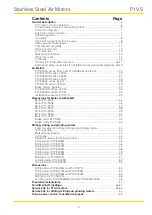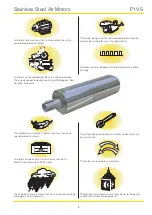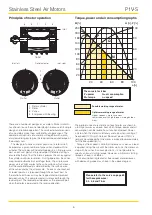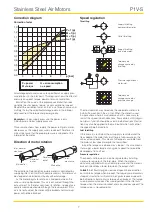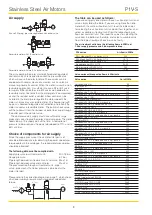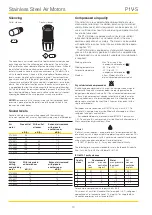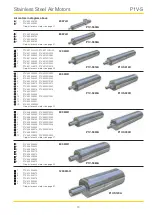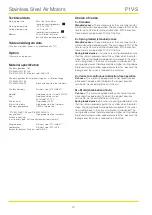
6
Stainless Steel Air Motors
P1V-S
Principles of motor operation
There are a number of designs of air motors. Parker Hannifin
has chosen to use the vane rotor design, because of its simple
design and reliable operation. The small external dimensions
of vane motors make them suitable for all applications. The
complete unit consists of a motor built together with a plan-
etary reduction gear to give the required speed and torque at
the output shaft.
The design of a vane air motor consists of a rotor which
incorporates a given number of vanes all enclosed within a
cylinder. The cylinder will include three ports; an inlet pressure
port, an exhaust port and a residual port. Reliable starting is
ensured by the fact that the inlet air presses the vanes against
the cylinder wall prior to rotation. During operation, the vanes
are pressed outwards by centrifugal force. The air pressure
always acts at right angles to the vane surface, which means
that the available torque is determined by the surface area
of the vanes and by the air pressure. As each vane reached
it’s lowest point air is released through the exhaust port. As
the rotation continues air may be trapped and compressed
between vanes. This compressed air is released through the
residual port. The residual port doubles as the pressure port
when the motor is operated in the reverse direction.
Inlet
Inlet, left
Residual outlet
Inlet, right
1 Rotor cylinder
Rotor
3 Vanes
4 End piece with bearing
The performance characteristics of each motor are shown in
a family of curves as above, from which torque, power and air
consumption can be read off as a function of speed. Power
is zero when the motor is stationary and also when running at
free speed (100%) with no load. Maximum power (100%) is
normally developed when the motor is braked to approximately
half the free speed (50%).
Torque at free speed is zero, but increases as soon as a load
is applied, rising linearly until the motor stalls. As the motor can
stop with the vanes in various positions, it is not possible to
specify an exact starting torque. However, a minimum starting
torque is shown in all tables.
Air consumption is greatest at free speed, and decreases
with decreasing speed, as shown in the above diagram.
Torque, power and air consumption graphs
1
2
3
Outlet
Outlet
4
3
1
2
4
Outlet
40
20
60
80
100
160
120
140
200
180
100
100
20
40
60
80
20
40
60
80
M
Q
P
Q [%], P [%]
M [%]
n [%]
Possible working range of motor.
Optimum working range of motor.
Higher speeds = more vane wear
Lower speeds with high torque = more gearbox
wear
The curve is for 6 bar
P = power
Q = air consumption
M = torque
n = speed
Please refer to the curve on page 65
for these pressures:
3, 4, 5, 6 and 7 bar
Summary of Contents for 1P1V-S020A00005
Page 66: ...66 Stainless Steel Air Motors P1V S...
Page 67: ......



